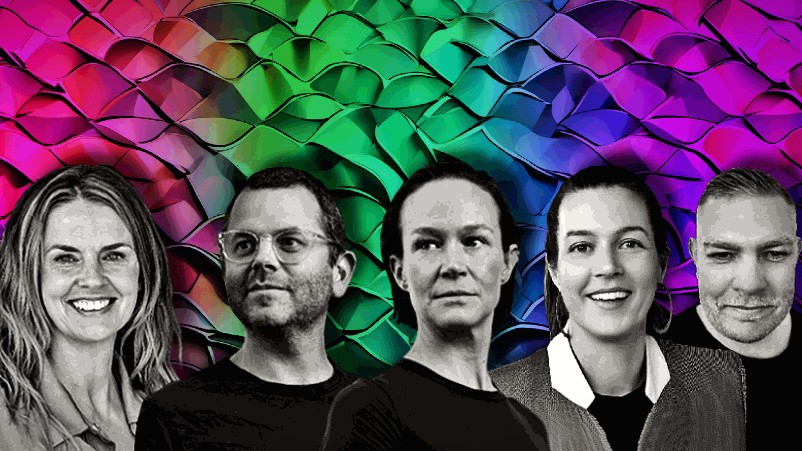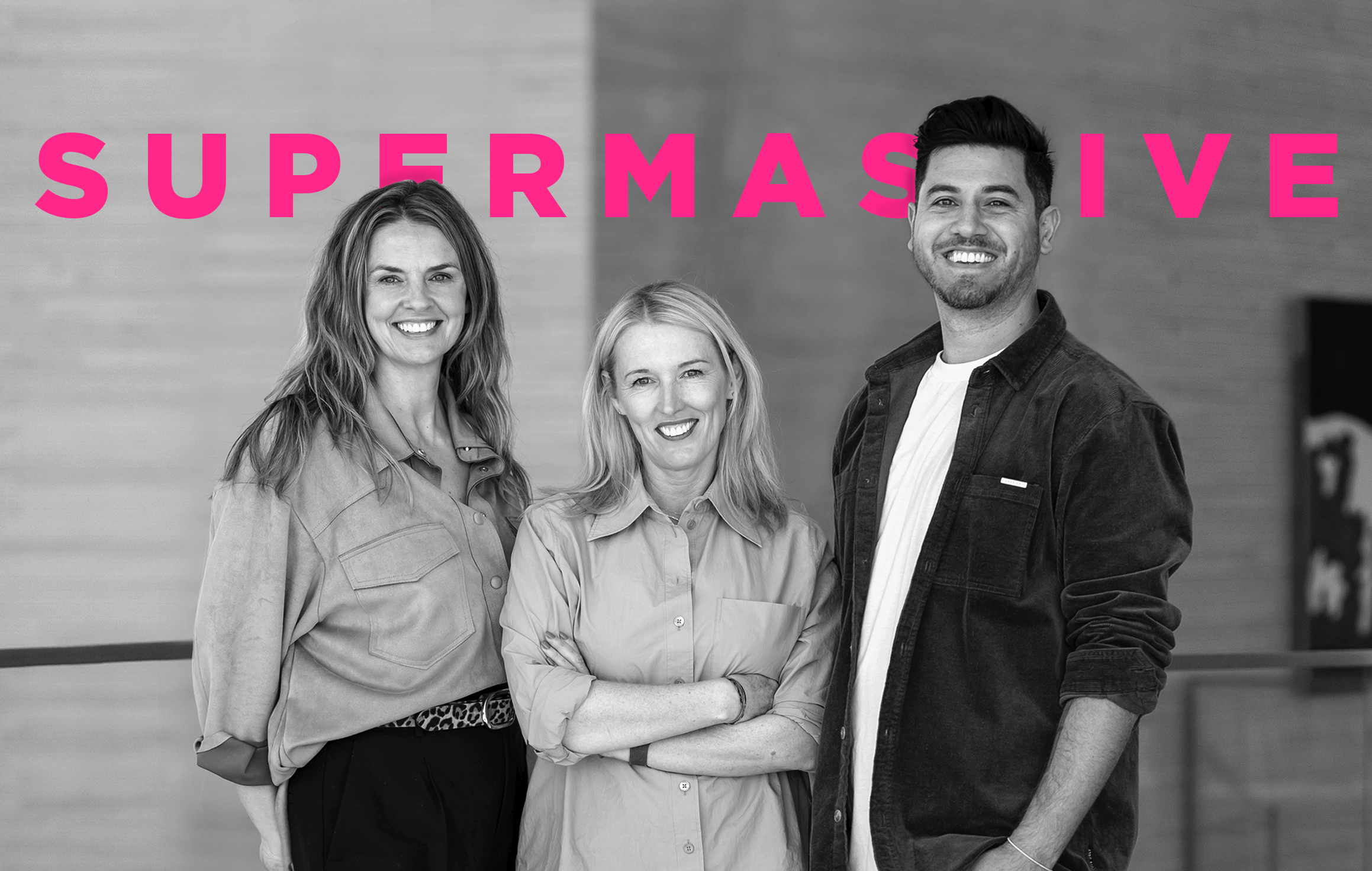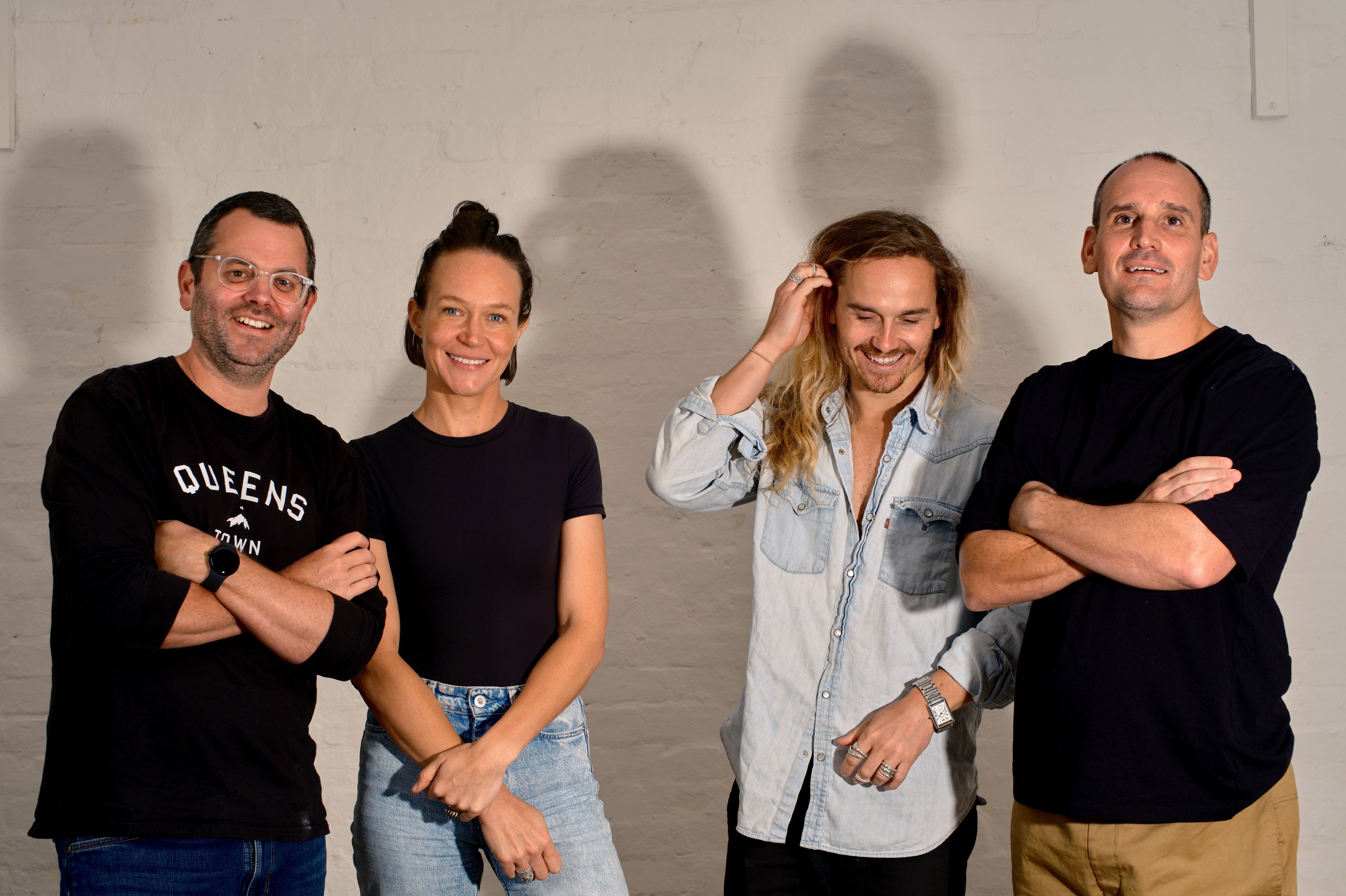Supermassive, Pembleton and Bureau founders buck consolidation trend, go small but scalable amid market flux, tightening budgets, exploding CMO remits

L-R: Laura Aldington, Alex Speakman, Matilda Hobba, Emily Taylor, and Cam Blackley
While the big agency groups aim to sew up top-end brands with end-to-end services, a new cohort of indies are flipping that model and touting tight, senior structures and “fractional” approaches that they say can scale and flex to suit the increasingly diverse business challenges facing marketers amid exploding remits. Supermassive, Pembleton and Bureau have all hit the market this last year with models they say does away with agency bloat and delivers specialist capability rather than square pegs in round holes – and don’t need retainers to stay afloat. Meanwhile as some small shops seek the safety of bigger groups as headwinds strengthen, these three see opportunity amid threat.
What you need to know:
- At least three fledgling indie shops have hit the market in the past 12 with a strikingly similar scalable proposition. Is a new trend emerging?
- Founders from Supermassive, Pembleton and Bureau have tapped a model that does away with delivery layers. They're going to market with lean, senior teams that can plug in other capabilities via freelance talent, agency partners, or in-house teams where needed.
- Their approaches, while nuanced, speak to a growing opportunity for highly agile service delivery.
- Per Pembleton co-founder and former Bullfrog MD Matilda Hobba, keeping the core team small means they won’t depend on retainers to keep afloat – a good thing given there's less going around, according to Supermassive co-founder and former Havas Host chief Laura Aldington.
- The scalable model is made possible by massive changes to the talent market following Covid. Now, suggests Aldington, much of the industry's best and most senior talent are "no longer housed in traditional agencies". That means that agencies are at liberty to “bring in incredible expertise on a fractional basis around specific business needs”.
- By embedding flexibility into the model, they're confident they'll be able to tackle the ever growing array of business problems facing marketers, and get more pieces of the pie without the need to build out capabilities in house.
- The fledging agencies also reckon they're well-positioned to adapt to the inevitable challenges of AI automation and in-housing that are rapidly coming at agencies. There's no need to be in the weeds of fast-moving technology either, says Hobba, as that will be for their external partners to deal with.
- But it's choppy market out there – and with big incoming waves, striking out as a small shop is a gamble. But the three new breed shops see opportunity amid threat.
Flex factor
As larger agency networks increasingly talk about a return to full service and the remerging of creative and media, a new breed of agile small firms is emerging with founders shedding the traditional creative agency fixtures for a lean, consulting-style model that they say is scalable, flexible, and future-proofed.
They say they’re responding to market challenges that have put pressure on client budgets and agency headcounts alike. So, they’re cutting the fat and going deep with clients to solve briefs that start at the core business problem, building out bespoke delivery teams using freelance talent and partner capabilities.
Supermassive, founded by ex-Havas trio Laura Aldington, Simone Gupta and Jon Austin (respectively former Havas Host chief, Havas PR chief and Havas Host executive creative director), has been testing out its scalable offer in market for the last year. It’s promise is to deliver fame-building work through brand strategy, earned expertise and creativity – the respective strengths of each of the three founders.
As Aldington tells Mi3, the Supermassive model “blends fixed and flexible resources”. The “fixed team” – currently the three founders and two other roles – lead the business and the client relationship, with the ability to engage freelance talent or plug into agency villages or in-house teams on a case-by-case basis.
“We are growing this fixed resource, of course, and will continue to do so to ensure we can deliver excellence in all three areas to clients,” she says. “But the flexible part allows us to augment our core team with specific skills or expertise to deliver a project to completion.”

Supermassive was launched last June by former Havas Network execs Laura Aldington, Simone Gupta, and Jon Austin (L-R)
Triple play
Then there’s newcomers Pembleton and Bureau of Everything. Both hit the market last month with barely a week between them.
Pitched as a ‘club house for ideas’, Pembleton is the brainchild of former Saatchi & Saatchi colleagues Simon Bagnasco, Alex Speakman, and Mac Wright, along with Matilda Hobba, who Bagnasco and Speakman linked with during their stint at Melbourne indie Bullfrog last year.
Their team is capped at the four founders – per Hobba they’ll work collaboratively “with the people closest to the business problem” on a project basis. With multidisciplinary capabilities across creative, strategy and project management, they’ve set out three scenarios in which they can work with clients: working directly to deliver projects, plugging into in-house agency models, or providing advisory services.

Pembleton founders Alex Speakman, Matilda Hobba, Mac Wright and Simon Bagnasco (L-R)
Problem solvers
Bureau, meanwhile, lives a little closer to what you might consider to be a more traditional creative agency. Positioned as a “creative office”, its “purposefully flexible” offering is driven by founders and former chief creative and chief strategist duo at M&C Saatchi, Cam Blackley and Emily Taylor. Like Supermassive, they’ll keep a lean core team and build out scalable bespoke solutions for clients with the help of freelance specialists.
Blackley says it’s an approach framed around creative and strategy, rather than an art director and copywriter. “We use that to identify the problem end to end, have a great stewardship and bring it all the way through, and then we can build the team that we need depending on the solution that we think creatively, any problem needs".

Cam Blackley (left) and Emily Taylor (right) formerly helmed creative and strategy together at M&C Saatchi
Burning fat
The decision to go out on your own typically comes down to two things – a perceived gap in the market and the founder’s desire to get back to their craft (and shake off corporate shackles). It’s no different for this cohort.
Per Aldington, her Supermassive co-founders “wanted to provide access to more senior talent and strip away many of the distractions or bureaucracy that [got] in the way”. It spoke both to what “clients needed” and what the three founders “wanted” – to get back to “working with brands in a hands-on capacity”.
It’s a sentiment that’s been heard by many a independent agency founder before, Emotive’s Simon Joyce and Avenue C’s Hugo Cutrone included. Collapsing traditional agency hierarchy into a flat structure is a sure way to do away with the bloat often found in larger firms.
There are the typical observations that clients want to work more directly with senior talent, they want a greater level of service, or they don’t have big retainer budgets – often, it’s all of the above. But sitting beneath that, there’s a firm belief that the needs of many clients are changed for good. "There's a lot more complication in the role that clients are doing," per Taylor.
Marketers remits have exploded in the last decade as brand, technology and commerce collide in a fast-evolving market. It's causing some CMOs to rethink their careers, per former Hipages customer chief turned headhunter Stuart Tucker.
Already stretched, marketers are now grappling with shrinking budgets, rising costs and slower growth amid a weakened consumer environment.
On the one hand, that’s made way for a consolidatory shift, with the likes of Accenture Song and Publicis Groupe wooing the top end of town via end-to-end offerings that promise to drive efficiency and effectiveness by breaking down the siloes between media, creative and technology – and apparently to great effect.
But for those clients without the budgets to retain services at that kind of scale, it appears, there is an opportunity to flip the end-to-end model on its head – all the while chasing the same level of flexibility.
Plug and play
Bureau’s Blackley and Taylor argue that keeping a lean core team is a boon for flexibility as they’re not limited by their in-house capabilities. Based on what they define in the strategic phase of a given brief, they’ll be able to plug in “certain skillsets” from freelancer talent or production partners into the firm’s core strategic and creative functions, says Taylor.
It’s an approach that’s naturally suited to project work (which Supermassive’s Aldington says is increasingly the status quo), but also lends itself to retained clients – which Bureau is looking to onboard.
The trend away from retainers, says Aldington has left typical agencies treading water to keep afloat – and she reckons it's impacting service.
“Many agencies are finding themselves with a large, fixed team and a workload that can be anything but – sometimes in terms of volume, but more often in terms of the diversity of work being undertaken at any one time,” she tells Mi3. “To maintain a decent margin, they need to ensure that their team is being utilised regardless of their suitability to a project. We wanted to instead make sure that clients were getting the team they really needed, not just being given whatever team happen to have capacity.”
To put it in numbers, Pembleton’s Speakman estimates that “a client that six years ago was $5 million, is probably a million-dollar client now”. Thus, the “typical agency model” is now only relevant to “a certain number of clients”, per Hobba.
By shedding the “fluff” and overheads of a more traditional structure, all three agency models have evolved without the pressure to bring in retained clients.
But Speakman is quick to preface that there’s still a place for some the bigger agencies, which the likes of Pembleton won’t be equipped to replace.
Likewise, Blackley says there’s still room for all models, shapes and sizes, but that only “the best of the best” will survive.
“It is a bit of a disruptive moment in time where everyone is thinking that there’s an urgency for change, and people and clients are open to rethinking how they problem solve.”
Talent unchained
The viability and of this kind of scalable model comes down to the evolution of the talent market, per Aldington, as “much of our industry's best, most senior talent [globally] are no longer housed in traditional agencies”.
For Hobba, that shift is at least partially due to the impacts of the pandemic, which freed “many of the talented people in advertising” from full-time gigs. Now, she says, “there's so much incredible talent across all spectrums”, from production to digital photography, writing, strategy and more that are increasingly selective about who they work with and "opting out of stressful, inflexible or outdated agency models”.
Aldington points to the opportunity this has created for agencies (new and old) to “bring in incredible expertise on a fractional basis around specific business needs” without the “inevitable limitations of the talent you have on a full-time basis”. It's the same story brand-side as the “fractional” resource model continues to gain momentum.
Aldington is careful to distinguish between a freelance or contract arrangement, and more long-term collaborators. While it might seem like semantics, she says the latter term speaks to the ongoing relationships the agency is building with its network of external talent and partners. “This model isn't about grabbing a few weeks work from someone who is between full time gigs”, she says, suggesting that “the idea of continuity is an interesting one anyway” given the “high levels of churn” currently experienced by agencies.
“If you came to Supermassive a year ago, 100 per cent of the flexible team we could have offered you then would still be available to you now and would very likely still be available in a year from now. In a more traditional set up, you'd be lucky if that number was 50 per cent,” she suggests.
Less is more
The flexible model also appears suited to an industry facing increasing AI-automation, with outsourcing, and in-housing also continuing their growth trajectory. Some small shops have read the runes and decided they needed a bigger boat, with the likes of creative shop Akkomplice merging into Howatson+Company.
“You guys know all the changes that are coming, the way the market's going, and I think if you're a small agency, like Akkomplice, there's some big waves out there to navigate,” Akkomplice founder Kenny Hill told Mi3 at the time.
But Bureau, Pembleton and Supermassive also see opportunity amid the flux.
“We are seeing some people really consolidating. But equally, I think there's a real trend towards specialists to do key capabilities,” says Taylor.
“I think we knew that in housing would be something that we could help out with, to bring some high-level kind of thinking to connect into that,” adds Blackley. “I think AI is just a natural bonus or offshoot that we'll be able to help with, because it is really just the rollout.”
In Pembleton’s case, the onus for keeping pace with technology sits with “other people”, says Hobba. “The way we position ourselves and the way we like to work ensures that that we don't get caught falling behind or not having the right tech.”
Likewise, Aldington reckons Supermassive’s model is inherently insulated from these “threats” because they’ll just be “extensions” of a model that already “operates on the basis that the team should be built to suit the task at hand”.
“AI can do the bulk of the studio work? Great. We have in-house PR but not design? No problem. We have in-house design but not PR? Cool. We can shape our team accordingly without ever diminishing the Supermassive promise – a fixed super senior, super diverse, super seasoned, and super engaged team who'll be by your side for the long term.”
She says it’s a way of working that industry should now be used to – “we've been working with production companies in this way for years”. And she’s seen the approach work at scale in the past during her time at Host – back before its Havas days.
“I spent several formative years at Host, which was once Australia's largest independent agency, and famously, it was a creative agency without a fixed creative department, preferring instead to partner with independent creative thinkers who could be cast to particular brands or briefs,” she recalls.
“Its founding principle, even back in 2000, was that clients needed increasingly diverse outputs, which required access to an increasingly diverse breadth and depth of talent, and that could be achieved by thoughtfully opening up your bench beyond your four walls.”
Havas' model has since has moved on. But the new model army is on the march.



